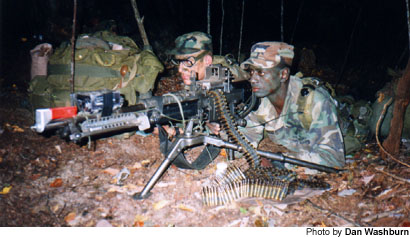
September 7, 1999 — Glassy-eyed, I sat at my computer trying to type. I wanted to capture some of the images of the previous 17 hours while they were still fresh in my mind.
But I was tired. I put my head in my hands. I needed to organize my thoughts. There were so many.
I returned my eyes to the blank screen. Then I noticed my hands. They were green. I forgot that I hadn’t yet removed all of the camouflage paint from my face.
“So when did Army Ranger training become a sport?” asked one of my colleagues. The name of this column is Sporting Life, after all.
“Well, we did some hiking,” I said, too tired to explain more. “That could be considered a sport.”
And we did hike — Ranger style — with little food, even less sleep, big guns and an enemy that could strike at any moment.
War isn’t a sport. It’s life or death.
Are the students at the Army Ranger school in Dahlonega, Ga. athletes? I don’t know.
I’m just glad they’re on our side.
0545 hours, arrive at Camp Frank D. Merrill, Dahlonega: Nestled in the seemingly serene mountains of Northeast Georgia sits Camp Merrill, home of phase two of the U.S. Army Ranger School and training grounds for some of the fiercest soldiers the world has ever seen.
The brutal 61-day Ranger Course, which begins at Fort Benning in Columbus and ends at Camp James E. Rudder in Florida, attracts the best the Army has to offer. It is designed to enhance the soldier’s ability to plan and execute small-unit combat missions in wooded, lowland swamp and mountainous environments.
The course is intentionally tough, designed to simulate the extreme mental and physical stress of battle … and then some. Many students don’t make it. Some of them elect to be “recycled” and try the course again. Others simply give up.
Upon completing the course and passing all of its requirements, students earn the right to wear the prestigious Ranger tab. The tab, a small green patch that reads “RANGER,” is modest but it signifies the adorned is the epitome of the U.S. infantryman.
Now Ranger-qualified, the graduates return to their original duties in the Army, prepared to assume a leadership role in any combat situation, trained to call upon the savage tactics of the Army Ranger when necessary.
0553, contact with Private Patrick E. Heffernan: My mission for the day was to “go walking” with Bravo Company on its field training exercise (FTX) in the mountains. Heffernan’s mission was to go with me.
We quickly breezed through the technicalities. I signed countless waivers and was outfitted with a battle-dress uniform, a patrolling cap, boots and a 30-pound rucksack.
I bombarded Hef with questions. I still wasn’t exactly sure what to expect. He responded briefly, politely.
“I’m sorry to rush you, sir, but this is my last day and I want to ride in a helicopter,” said Heffernan, 23, of Tyrone, Ga., a soldier in the Ranger Regiment who was about to receive a medical discharge.
0730, “camo-ing up”: There is an art to applying camouflage to the face. Use the dark end of the camo stick first. Color in the forehead, take it down the nose, then the chin. Draw from nose to ear, from nose down the neck. Fill in the rest with lime green.
“Did I do all right?” I asked Hef.
“Roger. You’re good to go,” he said.
0752, helicopter ride to Chestnut LZ: The roar of a UH-60 Blackhawk is unmistakable.
“Sounds like our ride,” said one of the Ranger Instructors, or RIs, with whom we were heading out to meet the students. We turned our backs as the chopper churned the air around us.
In the helicopter we had to don helmets, called kevlars. Mine was a little small. In my front pocket I had to carry two things: my signed waiver and my driver’s license, which would serve as my dog tag if we crashed. That hadn’t happened since 1975, I was assured.
We elevated quickly and I held the ill-fitting kevlar to my head tightly. Through the open door to my side, I watched the lush mountains of the Chattahoochee National Forest speed by below while my helmet’s chin strap flailed wildly in the wind.
0803, infiltrate student patrol base: I was wondering why we were whispering.
We hiked from the helicopter deep into the woods. The RIs were kneeling and whispering to each other. I didn’t know where we were.
“Don’t you see the students?” Hef asked me.
“What students?” I responded quizzically.
I didn’t see it, but the Bravo Company was there. There were 40 of them, just 20 yards away, quietly hidden in the woods before me. A large circle of them lay on their stomachs behind machine guns, scanning the forest for the enemy. In the middle, the rest took care of other patrol base activities.

They all were trying hard to stay awake.
They had been in this location for some six hours, in the mountains on this FTX for nearly three days. Most were working on less than two hours of sleep.
“It gets tough,” said Ranger student Antoine Overstreet from behind his machine gun. “Even when the sun’s up it’s still hard staying awake and staying focused. Last night we had guys falling asleep standing up.”
There was no time for sleeping now, however. The students had received the day’s mission: to strike an enemy logistics base just a few kilometers away.
The planning started immediately, even though the raid wasn’t scheduled for another 12 hours.
